Architecture is present in every corner of Portugal. Wherever you look, you will see a distinct style from a different age. Architecture can be exuberant, bold, and grandiose. It is a building’s soul and spirit and keeps many secrets.
Today we want you to know more about the most striking architectural style in Portugal: the Manueline style. If you have been to Portugal, in particular to Lisbon, you must have admired it a few times, but there is a lot behind this style that is unknown to many.
The Manueline style, also known as the Portuguese Late Gothic, is an architectural and decorative art style that flourished in Portugal during the reign of King Manuel I - hence the name - between 1495 and 1521. It is a quite eclectic and unique style that combines elements of Gothic, Renaissance and Moorish architecture, and most importantly, reflects the maritime and exploratory spirit of Portugal during the Age of Discoveries, a crucial part of the country’s cultural heritage. People believe that the maritime motifs are what really differentiate the Manueline style from any other, such as ropes, anchors, boats, shells, and sea creatures, very visible in the walls of any building of this era.
It also incorporates elements of nature, such as leaves, flowers and vines, as well as religious iconography, including the cross of the Order of Christ and the armillary sphere, another crucial piece of this era.
Find out all about the Manueline style and its manifestations throughout Portugal!
The Origin of the Manueline Style in Lisbon
Jerónimos Monastery

The most famous example of the Manueline style, and rightfully so, is the Jerónimos Monastery in the neighbourhood of Belém, built in the early 16th century.
It is one of the works that best expresses Manueline architecture, as it was commissioned by King Manuel I himself to honour the navigator Vasco da Gama and his great return from India. The monastery was handed over to the Order of Saint Jerome (hence the name, once again), who settled there until 1834. It survived the great earthquake of 1755 but was partially damaged during the French invasions at the beginning of the 20th century.
The monastery's façade is decorated with intricate carvings of valuable maritime motifs and the entrance is adorned with the statue of Prince Henry the Navigator, who played a major role in Portugal's explorations overseas.
The interior is equally impressive, with a spacious nave and choir decorated with ornate stone carvings and gilded woodwork. The Jerónimos Monastery also houses the tombs of several notable Portuguese figures. The navigator Vasco da Gama, who discovered the sea route to India, the poet Luís de Camões, author of Os Lusíadas, the Portuguese Epopee about the discoveries, and none other than the King Manuel I himself, the main protagonist of the Era of the Discoveries.
Tower of Belém
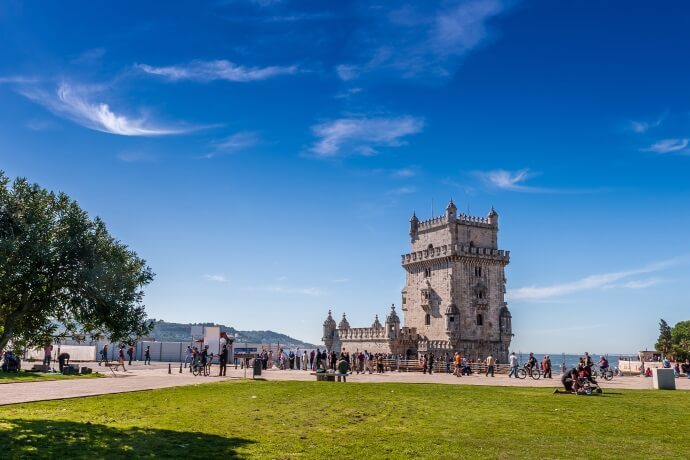
Another iconic example of the Manueline style is the Belém Tower, at a walking distance from the Monastery. It was built at the beginning of the 16th century in honour of St. Vincent, the city’s patron saint, and as a fortress to protect the entrance of Lisbon's harbour, equipped with various types of medieval artillery.
These two monuments in Belém represent the birth of this authentic Portuguese style, as they were built from scratch following the well-known sea motifs.
Nowadays it is one of the most popular attractions of Portugal, and its 30 meters definitely make it more imponent than what it looks like in pictures. From up close you will be able to see all of the symbols we have been talking about and more! Its façade displays several coats of arms of the country, making this building one of the most nationalistic in Portugal. You will also spot a rhino that King Manuel I won from the king of Cambaia, an Indian city. Everything has a hidden meaning behind it.
The interior of the tower is equally fascinating, with a spiral staircase leading to the top level and a small chapel on the first floor. The chapel is decorated with beautiful blue and white azulejo tiles, a common feature in Portuguese architecture. The top level, or the watchtower, offers breathtaking panoramic views of the Tagus River and the surrounding area.
Curiously, the tower first stood on a stone base in the middle of the river, completely surrounded by water. Due to the progressive shift in the course of the river over the years and the decrease in the volume of fresh water flowing down the river towards the sea, today the tower is connected to the mainland.
The Fusion of Eras in Architecture
Convent of Christ
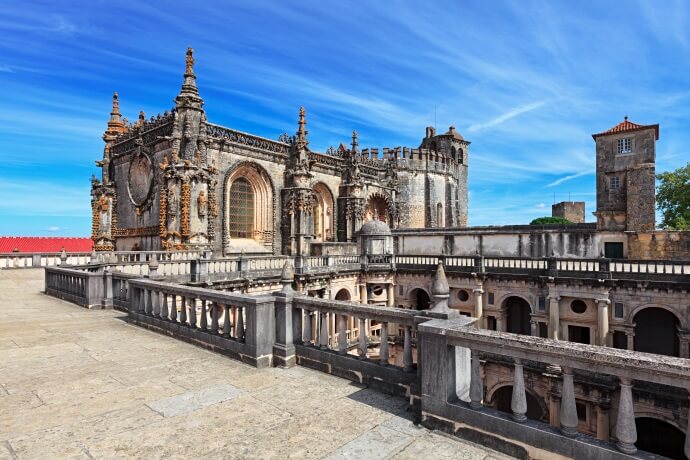
The Manueline style extends well beyond the capital - it is scattered around the country with a strong influence in smaller regions as well, mixed with the pre-existing architectural techniques.
A good example is the Convent of Christ in Tomar, originally a castle built in the 12th century by the Knights Templar, a Christian military order that played a significant role in the Crusades.
In the early 14th century, this castle was transformed into a convent and given to the Order of Christ, the successor to the Knights Templar in Portugal.
During the reign of King Manuel I, the Manueline style swooped in by surprise to adorn the walls of the convent, being more evident in the elaborate decorations on the portal of the main entrance and the highly famous window of the Chapter House, with the already familiar ocean and religious elements, such as the ropes, the cross of the Order of Christ and the armillary sphere.
Batalha Monastery
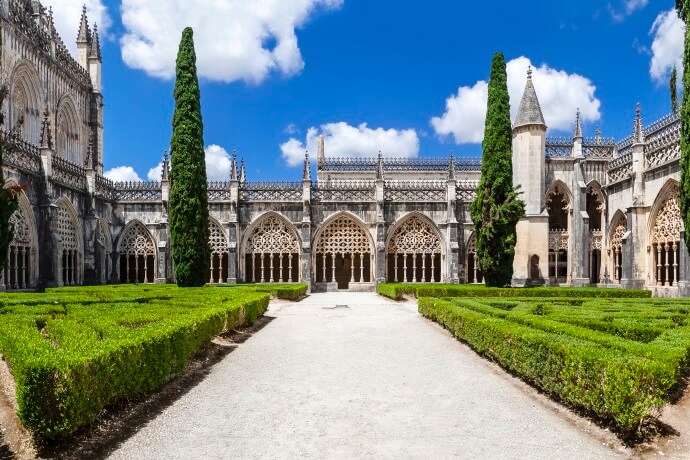
Continuing with another monument in central Portugal, the Batalha Monastery is a magnificent example of the Gothic style in the town of Batalha. It was built in the 14th century to celebrate the Portuguese victory against the Castilians at the Battle of Aljubarrota in 1385, one of the most memorable moments in Portuguese history.
When you visit this grandiose monastery, you will find evidence of the Portuguese style in the ornate portal, which features carvings of ropes, knots, anchors, and shells. The portal is topped by a statue of the Virgin Mary and Child, surrounded by sculpted sea creatures.
The highlight of the monastery is its beautiful cloister, which is considered one of the finest in Europe. Its columns and arches are ornamented with carvings of religious and secular figures, including saints, kings, and knights, as well as sculpted sea creatures and other maritime motifs, as expectable.
The Chapter House also boasts in grandiosity similar decorative elements, protected by its magnificent vaulted ceiling with star-shaped patterns and other geometric designs.
Jesus Monastery
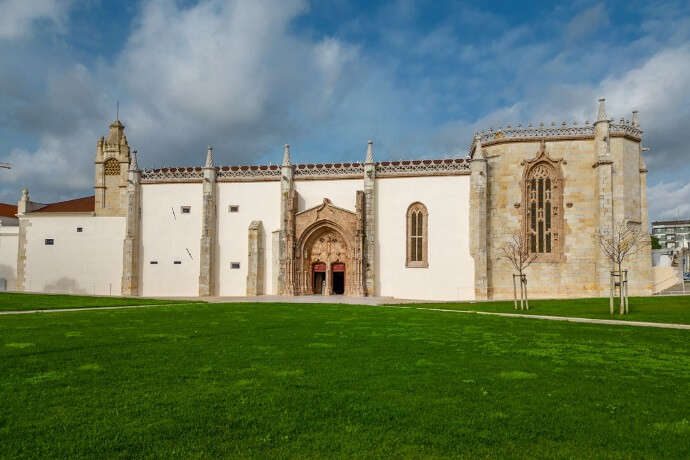
The Jesus Monastery in Setúbal, also known as the Jesus Convent, was founded in 1490 and was one of the few examples of a feminine convent in Portugal. It remained in operation until the beginning of the 19th century.
In terms of architecture, the monastery flaunts the Manueline style in full effect. Its ornate portal is a stunning example of the style's typical decoration and is flanked by two sculpted columns, which are topped by figures of saints, and above the portal is a balcony adorned with intricate tracery work.
On the inside, you will spot right away the carvings of religious and secular figures in the columns of the cloister. The church's interior and altarpiece are a must-see as well!
The Jesus Monastery is also home to the Museum of Setúbal, which showcases the history and cultural heritage of the region. The museum offers a range of exhibits, including archaeological artifacts, religious art, and historical documents, providing a glimpse into the rich and varied history of Setúbal!
National Palace of Sintra

The Manueline style has a strong presence in the fairy-tale villa of Sintra as well. This National Palace is one of the oldest palaces of Portugal, as it was first built in the 10th century by the Moors, shortly after the Moorish Castle, which surveyed and protected the city. The palace was believed to be the residence of the Moorish governors and that explains why it was much more luxurious than everything else around it. It was also a lot smaller than what it is today, since it used to be just the central part, where you can see now the arches and the fountain, key characteristics of the Arabic architecture.
Almost every king and queen of Portugal has lived in this palace, some during the Summer and others for years, and this led to numerous renovations and expansions. Well, it was in this very palace that King Manuel I was when he received the news of the discovery of Brazil in 1500, which boosted the whole movement of the discoveries and made the National Palace of Sintra a pillar of this era. Between 1505 and 1520, the so-called Manueline wing was built and, in 1508, the construction of the Room of Coats of Arms began. You can get a glimpse of this from the outside by looking at the windows, the ones on the right are more detailed and implement similar features as the one in the Convent of Christ.
Santa Cruz Monastery
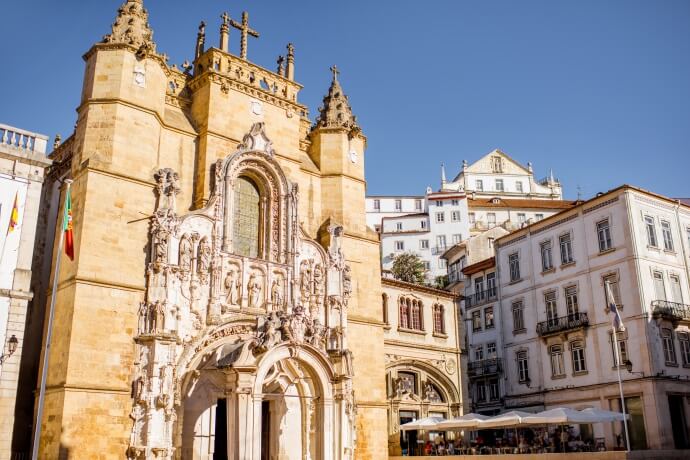
Towards the north of the country, it is possible to spot some Manueline details as well.
The city of Coimbra, known for its old university, is where the Monastery of Santa Cruz was founded in the 12th century by the first Portuguese king, Afonso Henriques.
The building has a long and complex history, with many additions and renovations over the centuries. After the year 1507, the monastery was redesigned in the Manueline style, with ornate decorative elements that reflected the wealth and power of the Portuguese monarchy. Beyond the typical stone carvings and nautical motifs, the king wanted this monastery to transmit a sense of grandeur and opulence.
On the inside, you will be able to admire a range of artworks and decorative elements, including elaborate altarpieces, colourful tiles, and wood carvings. The monastery also contains the tombs where several Portuguese monarchs and important figures lie, including King Afonso Henriques, King Sancho I, and King João III.
It is nowadays one of the country's most important religious and cultural landmarks and a testament to the Portuguese artistic and architectural achievements.
The Manueline Style 2.0
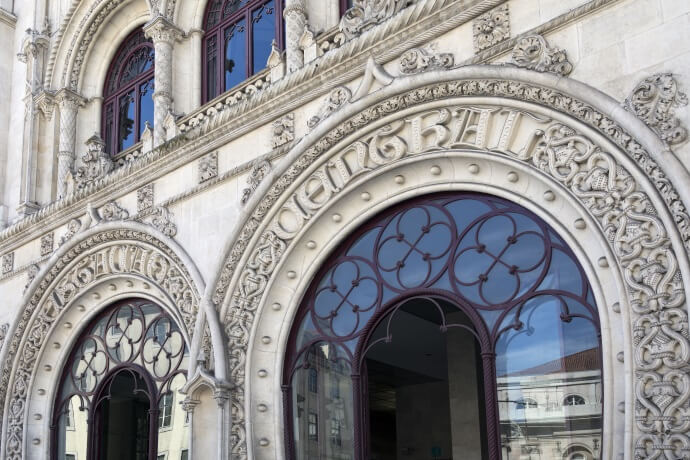
The popularity of the Manueline style declined after King Manuel I's reign ended, giving way to other architectural styles, such as Mannerism and Baroque. However, about 300 years later, the Manueline had a sudden come back as the Neo-Manueline style, a revivalist current that developed within Portuguese architecture and decorative arts between the mid-19th century and the beginning of the 20th century.
This new designation means “New Manueline” and it can be considered the 2.0 version of the previous style, with the same strength that Neo-Gothic had in the rest of Europe. Some buildings that showcase characteristics of the Neo-Manueline style are the Rossio train station, the Pena Palace, and Quinta da Regaleira.
The Pena Palace
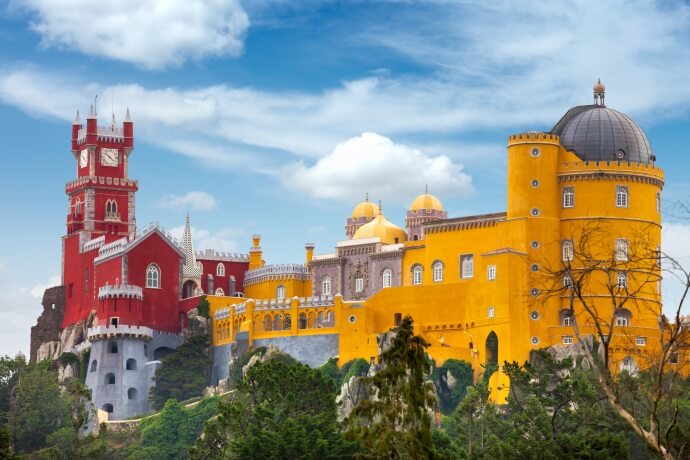
The Pena Palace is a very colourful building located at the top of the Sintra mountain range, with a truly unique landscape setting. It is a complex and unique building, individualized through the use of different artistic styles. The neo-Manueline set stands out for its red colour and is basically made up of the ruins of the former Jerónimo convent. There are, however, several elements clearly added and inspired by the great works of the reign of King Manuel I, such as the clock tower inspired by the Belém Tower or the famous copy of the window in the sacristy of the Convent of Christ in Tomar. This project was entirely designed by the Baron of Eschwege and King Fernando II, who wanted to pay tribute to the country's glorious past. It is the main Portuguese romantic building and, in 1995, it was classified by UNESCO as a World Heritage Site.
Quinta da Regaleira
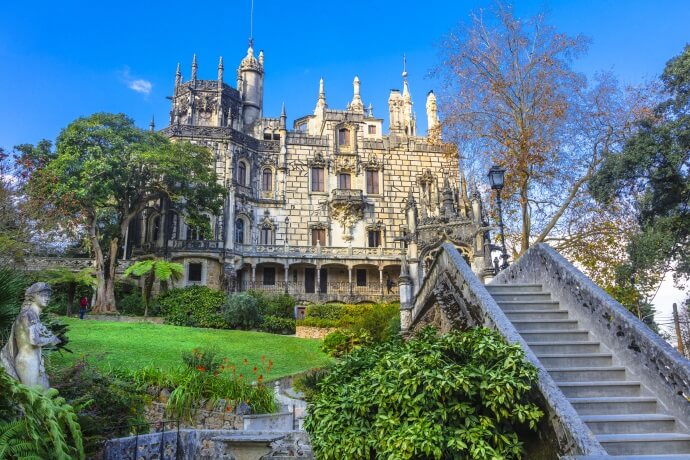
Quinta da Regaleira was one of the last buildings of the neo-Manueline period to be built. The construction started in 1904, according to Luigi Manini's project, remodelling the previous building.
When you see it at first, you will notice how green the gardens are and how mysterious everything looks, and that is due to all the references to Freemasonry.
When you start walking up towards the entrance, you will have to walk around the building, and that is when you will see right in front of you the impressive decorative set with all the elements we have been talking about: the armillary spheres, the cross of Christ, sea creatures, boats, and the ropes (so many ropes!).
The legacy of the Manueline style can be found in almost every Portuguese city, making it a crucial part of Portugal's cultural heritage. Most importantly, its grandiose decorative elements reflect the country's maritime past and its position as a global power during the Age of Discoveries, which is something the Portuguese people do not want to let go of.
Enjoy what nature has to offer you
Portugal is filled with hidden gems from top to bottom. Whether you are looking for a greener landscape or a turquoise shoreline, you are sure to find all kinds of natural paradises scattered across the country’s diverse set of parks. Explore some of the most stunning trails of Portugal and Europe alike, or simply take some time to unwind and soak up the invigorating atmosphere that nature so generously has to offer you.



